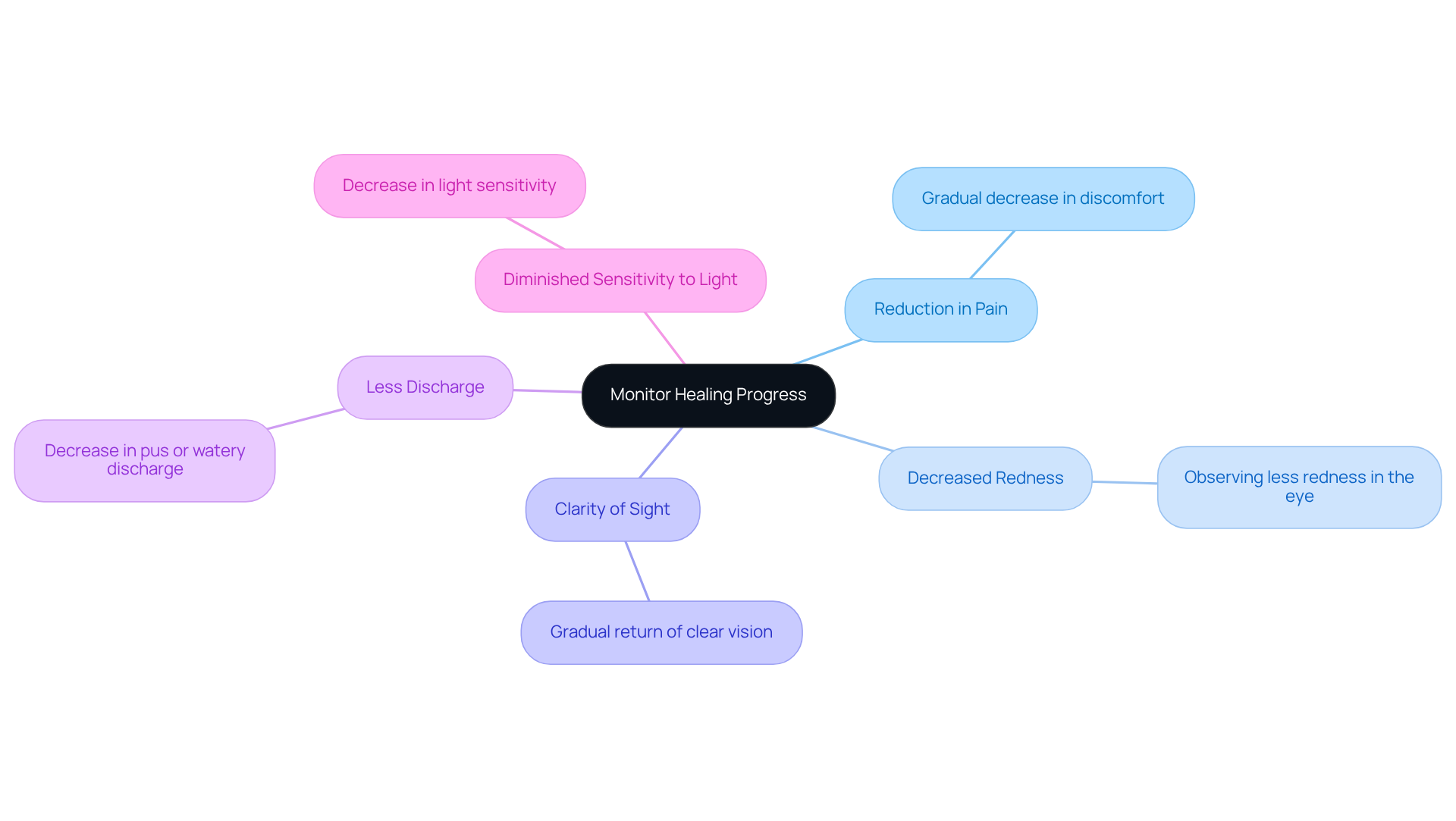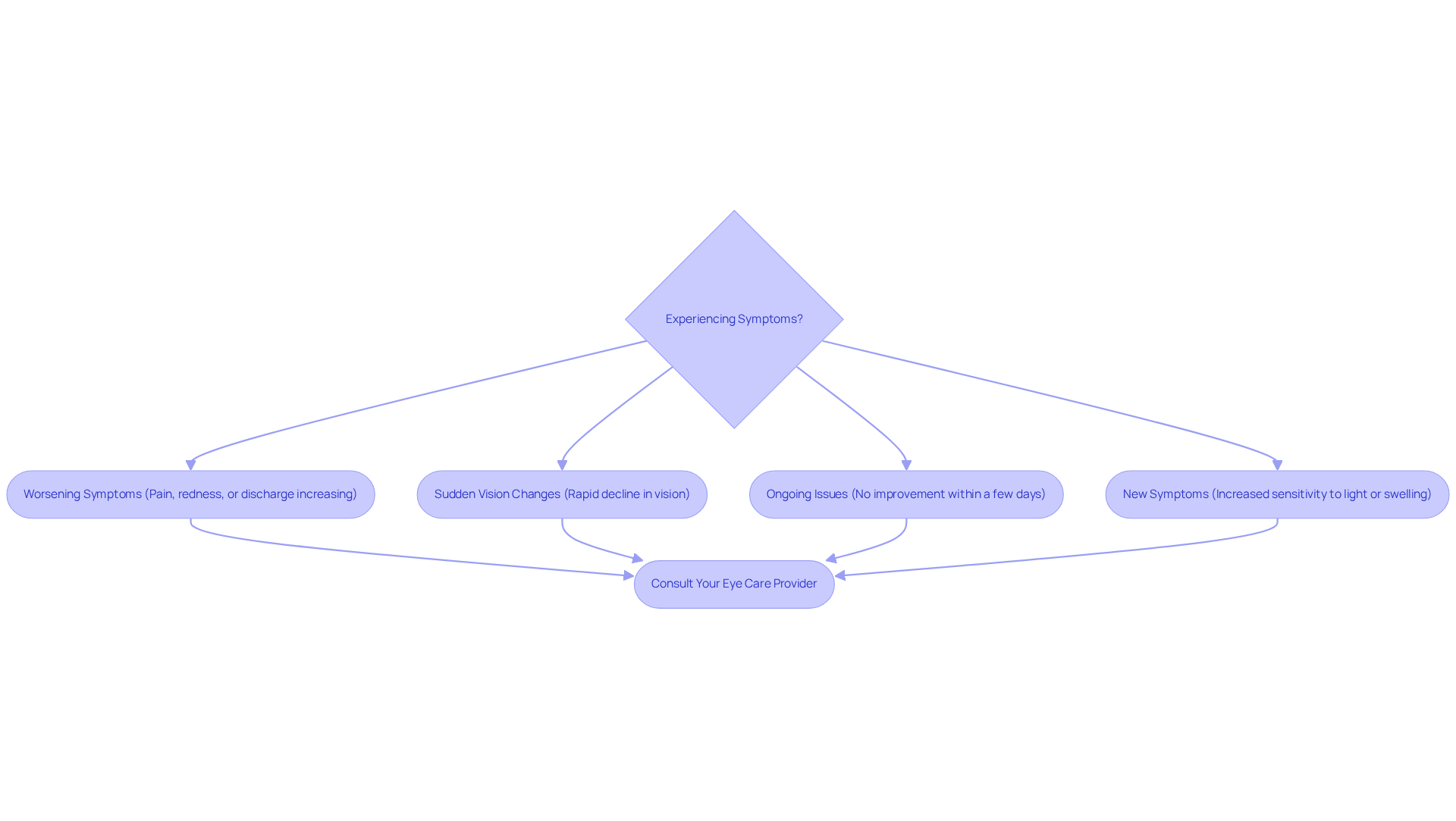Posted by: Northwest Eye in Cornea on November 24, 2025
Introduction
Understanding the nuances of corneal ulcers is vital for anyone experiencing eye discomfort. These painful lesions can lead to serious complications if left untreated. We understand that this can be a worrying time for you, and this guide delves into the essential signs indicating whether a corneal ulcer is healing. Our goal is to empower you with the knowledge to monitor your recovery effectively.
However, it’s common to feel anxious when symptoms persist or worsen despite treatment. Unraveling this question could be the key to preventing lasting damage and ensuring optimal eye health. Remember, we are here to help you through this process.
Understand Corneal Ulcers: Definition and Importance
A corneal lesion, often called keratitis, is an open sore on the cornea, the clear front surface of your eye. We understand that hearing about this can be concerning, as these lesions can arise from infections, injuries, or underlying eye conditions. It’s important to know that understanding corneal lesions is essential because they can lead to serious complications, including vision loss, if not addressed quickly.
Recognizing the signs of a corneal injury is crucial. You might notice symptoms like:
- Redness
- Pain
- Blurred vision
Observing the recovery process is equally important for understanding how to tell if a corneal ulcer is healing and preventing further complications. Remember, you’re not alone in this; many have faced similar challenges and found their way to recovery.
If you ever feel uncertain or worried, please reach out for help. We are here to support you through this process and ensure you receive the care you need.

Identify Symptoms of Corneal Ulcers
If you’re experiencing symptoms of corneal ulcers, it’s important to know that you’re not alone. Many people face similar challenges, and understanding these signs can help you seek the care you need. Here are some common symptoms to watch for:
- Severe eye pain: This pain can feel sharp or throbbing, and many individuals report it as a significant discomfort. It’s crucial to pay attention to this symptom, as it often indicates worsening conditions.
- Redness: You might notice that your affected eye appears bloodshot, which signals inflammation.
- Discharge: Some patients experience pus or watery discharge, which can vary in consistency.
- Sensitivity to light: If bright environments cause you increased discomfort, this is a frequent complaint that may indicate potential severity.
- Blurred vision: Hazy or distorted vision can prompt immediate attention, so don’t hesitate to reach out for help.
- Foreign body sensation: A persistent feeling of something in your eye can be distressing, and many individuals report this sensation.
It is essential to identify these signs early to understand how to tell if corneal ulcer is healing. We understand that knowing how to tell if corneal ulcer is healing can greatly enhance recovery and help avoid complications. In the U.S., corneal lesions occur yearly in approximately 30,000 to 75,000 cases, highlighting the importance of awareness.
Ophthalmologists emphasize the need for patients to adhere to treatment guidelines and seek assistance if symptoms escalate. Remember, untreated corneal lesions can lead to lasting harm to your sight. We are here to help you through this process, so don’t hesitate to reach out for support.

Monitor Healing Progress: Key Indicators
As a corneal ulcer heals, it’s important to keep an eye on several key indicators that can help you monitor your progress:
- Reduction in pain: A gradual decrease in discomfort is a positive sign that healing is underway.
- Decreased redness: Over time, observing decreased redness in your eye can help you understand how to tell if corneal ulcer is healing, which is encouraging.
- How to tell if corneal ulcer is healing: You may notice that clarity of sight gradually returns, which brings you relief.
- Less discharge: A decrease in pus or watery discharge is an indicator of how to tell if corneal ulcer is healing.
- Diminished sensitivity to light: As you heal, a decrease in light sensitivity can be an indicator of how to tell if corneal ulcer is healing, making you more comfortable.
We understand that this process can be concerning, and it’s common to feel anxious about your recovery. If you notice that these indicators do not improve within a few days of treatment, please don’t hesitate to consult your eye care provider. We are here to help you through this process.

Take Action: When to Consult Your Eye Care Provider
If you’re experiencing any of the following, we encourage you to consult your eye care provider:
- Worsening symptoms: If you notice that pain, redness, or discharge is increasing despite treatment, it’s important to seek help. This could indicate a more serious issue that needs attention.
- Sudden vision changes: A rapid decline in your vision should be addressed immediately. It’s common to feel anxious about this, but prompt care can make a significant difference.
- Ongoing issues: If your problems aren’t improving within a few days of starting treatment, don’t hesitate to reach out. Further evaluation may be necessary to adjust your care plan and ensure you’re on the right track.
- New symptoms: Increased sensitivity to light or swelling around the eye can be signs of worsening conditions. We understand that this can be concerning, and it’s essential to get prompt attention.
Timely consultation can help prevent serious complications, including permanent vision loss. Remember, we are here to help you through this process and ensure you receive the appropriate treatment for your condition.

Conclusion
Understanding the healing process of corneal ulcers is vital for maintaining eye health and preventing potential complications. We understand that recognizing the signs of healing can provide reassurance and empower you to take proactive steps in your recovery journey. By staying informed and vigilant, you can effectively monitor your progress and seek timely medical advice when necessary.
Throughout this article, we highlighted several key indicators of healing. These include:
- A reduction in pain and redness
- Improved clarity of vision
- Decreased discharge
- Diminished sensitivity to light
Each of these signs serves as a crucial marker for assessing whether a corneal ulcer is on the path to recovery. It’s common to feel concerned, so remember that any worsening symptoms or sudden changes in vision should prompt immediate consultation with your eye care provider to avoid serious complications.
Ultimately, the importance of being proactive in eye health cannot be overstated. By understanding the symptoms and monitoring the healing process of corneal ulcers, you can significantly enhance your chances of a full recovery. Awareness and timely action are essential in preventing lasting damage to your vision. Therefore, if you experience symptoms of a corneal ulcer, please don’t hesitate to seek professional help. We are here to help you through this process, ensuring a healthier future for your eyes.
Frequently Asked Questions
What is a corneal ulcer?
A corneal ulcer, also known as keratitis, is an open sore on the cornea, which is the clear front surface of the eye.
What causes corneal ulcers?
Corneal ulcers can arise from infections, injuries, or underlying eye conditions.
Why is it important to understand corneal ulcers?
Understanding corneal ulcers is essential because they can lead to serious complications, including vision loss, if not addressed quickly.
What are the common symptoms of a corneal ulcer?
Common symptoms include redness, pain, and blurred vision.
How can I tell if a corneal ulcer is healing?
Observing the recovery process is important for understanding if a corneal ulcer is healing, although specific signs of healing were not detailed in the article.
What should I do if I am concerned about a corneal ulcer?
If you feel uncertain or worried about a corneal ulcer, it is important to reach out for help and seek care.






